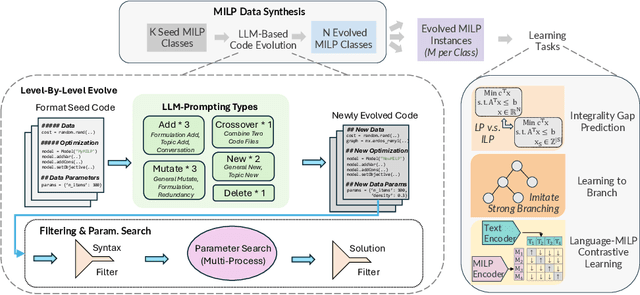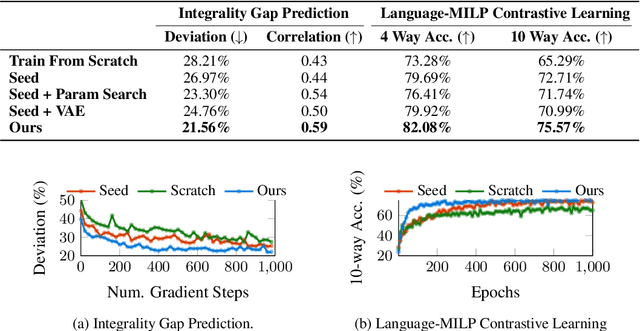Sirui Li
Washington University in St. Louis
Automated Formalization via Conceptual Retrieval-Augmented LLMs
Aug 09, 2025



Abstract:Interactive theorem provers (ITPs) require manual formalization, which is labor-intensive and demands expert knowledge. While automated formalization offers a potential solution, it faces two major challenges: model hallucination (e.g., undefined predicates, symbol misuse, and version incompatibility) and the semantic gap caused by ambiguous or missing premises in natural language descriptions. To address these issues, we propose CRAMF, a Concept-driven Retrieval-Augmented Mathematical Formalization framework. CRAMF enhances LLM-based autoformalization by retrieving formal definitions of core mathematical concepts, providing contextual grounding during code generation. However, applying retrieval-augmented generation (RAG) in this setting is non-trivial due to the lack of structured knowledge bases, the polymorphic nature of mathematical concepts, and the high precision required in formal retrieval. We introduce a framework for automatically constructing a concept-definition knowledge base from Mathlib4, the standard mathematical library for the Lean 4 theorem prover, indexing over 26,000 formal definitions and 1,000+ core mathematical concepts. To address conceptual polymorphism, we propose contextual query augmentation with domain- and application-level signals. In addition, we design a dual-channel hybrid retrieval strategy with reranking to ensure accurate and relevant definition retrieval. Experiments on miniF2F, ProofNet, and our newly proposed AdvancedMath benchmark show that CRAMF can be seamlessly integrated into LLM-based autoformalizers, yielding consistent improvements in translation accuracy, achieving up to 62.1% and an average of 29.9% relative improvement.
SpeechRefiner: Towards Perceptual Quality Refinement for Front-End Algorithms
Jun 16, 2025Abstract:Speech pre-processing techniques such as denoising, de-reverberation, and separation, are commonly employed as front-ends for various downstream speech processing tasks. However, these methods can sometimes be inadequate, resulting in residual noise or the introduction of new artifacts. Such deficiencies are typically not captured by metrics like SI-SNR but are noticeable to human listeners. To address this, we introduce SpeechRefiner, a post-processing tool that utilizes Conditional Flow Matching (CFM) to improve the perceptual quality of speech. In this study, we benchmark SpeechRefiner against recent task-specific refinement methods and evaluate its performance within our internal processing pipeline, which integrates multiple front-end algorithms. Experiments show that SpeechRefiner exhibits strong generalization across diverse impairment sources, significantly enhancing speech perceptual quality. Audio demos can be found at https://speechrefiner.github.io/SpeechRefiner/.
Autoformalization in the Era of Large Language Models: A Survey
May 29, 2025Abstract:Autoformalization, the process of transforming informal mathematical propositions into verifiable formal representations, is a foundational task in automated theorem proving, offering a new perspective on the use of mathematics in both theoretical and applied domains. Driven by the rapid progress in artificial intelligence, particularly large language models (LLMs), this field has witnessed substantial growth, bringing both new opportunities and unique challenges. In this survey, we provide a comprehensive overview of recent advances in autoformalization from both mathematical and LLM-centric perspectives. We examine how autoformalization is applied across various mathematical domains and levels of difficulty, and analyze the end-to-end workflow from data preprocessing to model design and evaluation. We further explore the emerging role of autoformalization in enhancing the verifiability of LLM-generated outputs, highlighting its potential to improve both the trustworthiness and reasoning capabilities of LLMs. Finally, we summarize key open-source models and datasets supporting current research, and discuss open challenges and promising future directions for the field.
TAGS: 3D Tumor-Adaptive Guidance for SAM
May 21, 2025Abstract:Foundation models (FMs) such as CLIP and SAM have recently shown great promise in image segmentation tasks, yet their adaptation to 3D medical imaging-particularly for pathology detection and segmentation-remains underexplored. A critical challenge arises from the domain gap between natural images and medical volumes: existing FMs, pre-trained on 2D data, struggle to capture 3D anatomical context, limiting their utility in clinical applications like tumor segmentation. To address this, we propose an adaptation framework called TAGS: Tumor Adaptive Guidance for SAM, which unlocks 2D FMs for 3D medical tasks through multi-prompt fusion. By preserving most of the pre-trained weights, our approach enhances SAM's spatial feature extraction using CLIP's semantic insights and anatomy-specific prompts. Extensive experiments on three open-source tumor segmentation datasets prove that our model surpasses the state-of-the-art medical image segmentation models (+46.88% over nnUNet), interactive segmentation frameworks, and other established medical FMs, including SAM-Med2D, SAM-Med3D, SegVol, Universal, 3D-Adapter, and SAM-B (at least +13% over them). This highlights the robustness and adaptability of our proposed framework across diverse medical segmentation tasks.
DocSpiral: A Platform for Integrated Assistive Document Annotation through Human-in-the-Spiral
May 06, 2025Abstract:Acquiring structured data from domain-specific, image-based documents such as scanned reports is crucial for many downstream tasks but remains challenging due to document variability. Many of these documents exist as images rather than as machine-readable text, which requires human annotation to train automated extraction systems. We present DocSpiral, the first Human-in-the-Spiral assistive document annotation platform, designed to address the challenge of extracting structured information from domain-specific, image-based document collections. Our spiral design establishes an iterative cycle in which human annotations train models that progressively require less manual intervention. DocSpiral integrates document format normalization, comprehensive annotation interfaces, evaluation metrics dashboard, and API endpoints for the development of AI / ML models into a unified workflow. Experiments demonstrate that our framework reduces annotation time by at least 41\% while showing consistent performance gains across three iterations during model training. By making this annotation platform freely accessible, we aim to lower barriers to AI/ML models development in document processing, facilitating the adoption of large language models in image-based, document-intensive fields such as geoscience and healthcare. The system is freely available at: https://app.ai4wa.com. The demonstration video is available: https://app.ai4wa.com/docs/docspiral/demo.
SymbioticRAG: Enhancing Document Intelligence Through Human-LLM Symbiotic Collaboration
May 05, 2025Abstract:We present \textbf{SymbioticRAG}, a novel framework that fundamentally reimagines Retrieval-Augmented Generation~(RAG) systems by establishing a bidirectional learning relationship between humans and machines. Our approach addresses two critical challenges in current RAG systems: the inherently human-centered nature of relevance determination and users' progression from "unconscious incompetence" in query formulation. SymbioticRAG introduces a two-tier solution where Level 1 enables direct human curation of retrieved content through interactive source document exploration, while Level 2 aims to build personalized retrieval models based on captured user interactions. We implement Level 1 through three key components: (1)~a comprehensive document processing pipeline with specialized models for layout detection, OCR, and extraction of tables, formulas, and figures; (2)~an extensible retriever module supporting multiple retrieval strategies; and (3)~an interactive interface that facilitates both user engagement and interaction data logging. We experiment Level 2 implementation via a retriever strategy incorporated LLM summarized user intention from user interaction logs. To maintain high-quality data preparation, we develop a human-on-the-loop validation interface that improves pipeline output while advancing research in specialized extraction tasks. Evaluation across three scenarios (literature review, geological exploration, and education) demonstrates significant improvements in retrieval relevance and user satisfaction compared to traditional RAG approaches. To facilitate broader research and further advancement of SymbioticRAG Level 2 implementation, we will make our system openly accessible to the research community.
Learning-Guided Rolling Horizon Optimization for Long-Horizon Flexible Job-Shop Scheduling
Feb 18, 2025Abstract:Long-horizon combinatorial optimization problems (COPs), such as the Flexible Job-Shop Scheduling Problem (FJSP), often involve complex, interdependent decisions over extended time frames, posing significant challenges for existing solvers. While Rolling Horizon Optimization (RHO) addresses this by decomposing problems into overlapping shorter-horizon subproblems, such overlap often involves redundant computations. In this paper, we present L-RHO, the first learning-guided RHO framework for COPs. L-RHO employs a neural network to intelligently fix variables that in hindsight did not need to be re-optimized, resulting in smaller and thus easier-to-solve subproblems. For FJSP, this means identifying operations with unchanged machine assignments between consecutive subproblems. Applied to FJSP, L-RHO accelerates RHO by up to 54% while significantly improving solution quality, outperforming other heuristic and learning-based baselines. We also provide in-depth discussions and verify the desirable adaptability and generalization of L-RHO across numerous FJSP variates, distributions, online scenarios and benchmark instances. Moreover, we provide a theoretical analysis to elucidate the conditions under which learning is beneficial.
MILP initialization for solving parabolic PDEs with PINNs
Jan 27, 2025Abstract:Physics-Informed Neural Networks (PINNs) are a powerful deep learning method capable of providing solutions and parameter estimations of physical systems. Given the complexity of their neural network structure, the convergence speed is still limited compared to numerical methods, mainly when used in applications that model realistic systems. The network initialization follows a random distribution of the initial weights, as in the case of traditional neural networks, which could lead to severe model convergence bottlenecks. To overcome this problem, we follow current studies that deal with optimal initial weights in traditional neural networks. In this paper, we use a convex optimization model to improve the initialization of the weights in PINNs and accelerate convergence. We investigate two optimization models as a first training step, defined as pre-training, one involving only the boundaries and one including physics. The optimization is focused on the first layer of the neural network part of the PINN model, while the other weights are randomly initialized. We test the methods using a practical application of the heat diffusion equation to model the temperature distribution of power transformers. The PINN model with boundary pre-training is the fastest converging method at the current stage.
TimelineKGQA: A Comprehensive Question-Answer Pair Generator for Temporal Knowledge Graphs
Jan 08, 2025



Abstract:Question answering over temporal knowledge graphs (TKGs) is crucial for understanding evolving facts and relationships, yet its development is hindered by limited datasets and difficulties in generating custom QA pairs. We propose a novel categorization framework based on timeline-context relationships, along with \textbf{TimelineKGQA}, a universal temporal QA generator applicable to any TKGs. The code is available at: \url{https://github.com/PascalSun/TimelineKGQA} as an open source Python package.
Towards Foundation Models for Mixed Integer Linear Programming
Oct 10, 2024



Abstract:Mixed Integer Linear Programming (MILP) is essential for modeling complex decision-making problems but faces challenges in computational tractability and requires expert formulation. Current deep learning approaches for MILP focus on specific problem classes and do not generalize to unseen classes. To address this shortcoming, we take a foundation model training approach, where we train a single deep learning model on a diverse set of MILP problems to generalize across problem classes. As existing datasets for MILP lack diversity and volume, we introduce MILP-Evolve, a novel LLM-based evolutionary framework that is capable of generating a large set of diverse MILP classes with an unlimited amount of instances. We study our methodology on three key learning tasks that capture diverse aspects of MILP: (1) integrality gap prediction, (2) learning to branch, and (3) a new task of aligning MILP instances with natural language descriptions. Our empirical results show that models trained on the data generated by MILP-Evolve achieve significant improvements on unseen problems, including MIPLIB benchmarks. Our work highlights the potential of moving towards a foundation model approach for MILP that can generalize to a broad range of MILP applications. We are committed to fully open-sourcing our work to advance further research.
 Add to Chrome
Add to Chrome Add to Firefox
Add to Firefox Add to Edge
Add to Edge